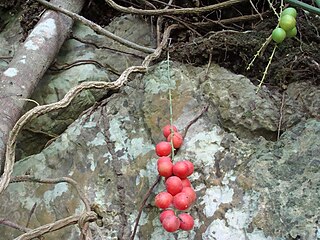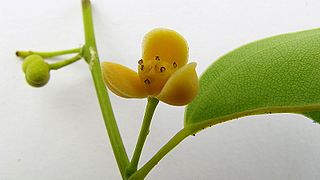
Paullinia is a genus of flowering shrubs, small trees and lianas in the soapberry family, Sapindaceae and typical of tribe Paullinieae. It is native to tropical South America, Central America and the Caribbean.

Menispermaceae is a family of flowering plants. The alkaloid tubocurarine, a neuromuscular blocker and the active ingredient in the 'tube curare' form of the dart poison curare, is derived from the South American liana Chondrodendron tomentosum. Several other South American genera belonging to the family have been used to prepare the 'pot' and 'calabash' forms of curare. The family contains 78 genera with some 440 species, which are distributed throughout low-lying tropical areas with some species present in temperate and arid regions.

Anomospermum is a genus of flowering plants in the family Menispermaceae. It consists of five species from tropical America, ranging from Nicaragua to southern Brazil.

Odontocarya is a plant genus in the family Menispermaceae. It includes 38 species native to the tropical Americas, ranging from southern Mexico to northern Argentina.

Cleome is a genus of flowering plants in the family Cleomaceae, commonly known as spider flowers, spider plants, spider weeds, or bee plants. Previously, it had been placed in the family Capparaceae, until DNA studies found the Cleomaceae genera to be more closely related to the Brassicaceae than the Capparaceae. Cleome and clammyweed can sometimes be confused.
Curarea candicans is a species of flowering plant in the family Menispermaceae.

Cissampelos is a genus of flowering plants in the family Menispermaceae. Various species of this genus have a history of use in various traditions of herbal medicine. Moreover, many of these plants were used as curare applied as arrow poison during hunting.

Doliocarpus is a genus of flowering plants in the family Dilleniaceae, native to Central and South America.
Curarea is a genus of flowering plants in the family Menispermaceae, found in tropical parts of Central and South America. They are dioecious lianas, with at least some species producing toxic compounds such as curare.
Morisonia is a genus of flowering plants in the family Capparaceae, found across the Americas from the United States to Argentina. They are typically shrubs or small trees. The genus was recently enlarged with New World Capparis species due to existing taxonomic instability.

Disciphania is a genus of flowering plants belonging to the family Menispermaceae.

Orthomene is a genus of flowering plants belonging to the family Menispermaceae.
Sciadotenia is a genus of flowering plants belonging to the family Menispermaceae.
Abuta candollei is a species of flowering plant in the family Menispermaceae. The species can be found in Brazil, Guyana, Suriname, and French Guiana.

Abuta colombiana is a species of flowering plant in the Menispermaceae family. It is part of the genus Abuta, which consists of about 32 species native to tropical Central and South America. Abuta colombiana is native to Colombia and northern Brazil, and has been observed in Ecuador and Panama. It was first published in Brittonia in 1938, described from two specimens collected from the Chocó Department in north Colombia. It is closely related to Abuta imene but can be distinguished by the flower stamens.
Abuta dwyeriana is a species of the Abuta genus, which is part of the flowering plant family Menispermaceae.
Abuta pahnii is a species of the Abuta genus, which is part of the flowering plant family Menispermaceae. This genus consists of about 32 species, native to tropical Central and South America.
Abuta fluminum is a species of flowering plant in the family Menispermaceae.










